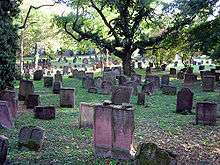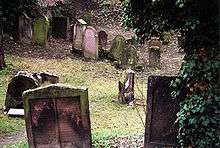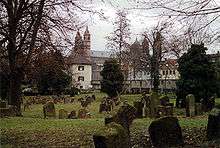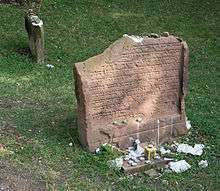Jewish Cemetery, Worms



The Jewish Cemetery in Worms or Heiliger Sand, in Worms, Germany, is usually called the oldest surviving Jewish cemetery in Europe,[2] although the Jewish burials in the Jewish sections of the Roman catacombs predate it by a millennium. The Jewish community of Worms was established by the early eleventh century, and the oldest tombstone still legible dates from 1058/59.[3] The cemetery was closed in 1911, when a new cemetery was inaugurated. Some family burials continued until the late 1930s. The older part still contains about 1,300 tombstones, the newer part (on the wall of the former city fortifications, acquired after 1689) more than 1,200. The cemetery is protected and cared for by the city of Worms, the Jewish community of Mainz-Worms, and the Landesdenkmalamt of Rhineland-Palatinate. The Salomon L. Steinheim-Institute for German-Jewish History at the University of Duisburg-Essen has been documenting and researching it since 2005.
Notable people buried at the cemetery
- Yaakov ben Moshe Levi Moelin (Maharil)
- Meir of Rothenburg (Maharam Rothenburg)
- Yair Bacharach
- Moses Samson Bacharach
Gallery
 Gravestone dated 1076/1077: Yaakov ha-bahur
Gravestone dated 1076/1077: Yaakov ha-bahur Gravestones of Rabbi Meir of Rothenburg (left) and Alexander ben Salomo Wimpfen
Gravestones of Rabbi Meir of Rothenburg (left) and Alexander ben Salomo Wimpfen Grave of Yaakov ben Moshe Levi Moelin, also known as Maharil
Grave of Yaakov ben Moshe Levi Moelin, also known as Maharil Mortuary
Mortuary Cemetery in 2012
Cemetery in 2012 Cemetery in 2012, showing various styles of headstone
Cemetery in 2012, showing various styles of headstone
Illustrations
References
- ↑ SchUM-Städte am Rhein Newsletter 1, SchUM-Städte Speyer, Worms, Mainz e.V.; November 2017 https://schumstaedte.de/files/schum_newsletter1_11_2017.pdf (in German)
- ↑ Heiliger Sand (Jewish Cemetery), Worms
- ↑ Epidat: Jüdischer Friedhof Worms: Inv.-Nr. 9008